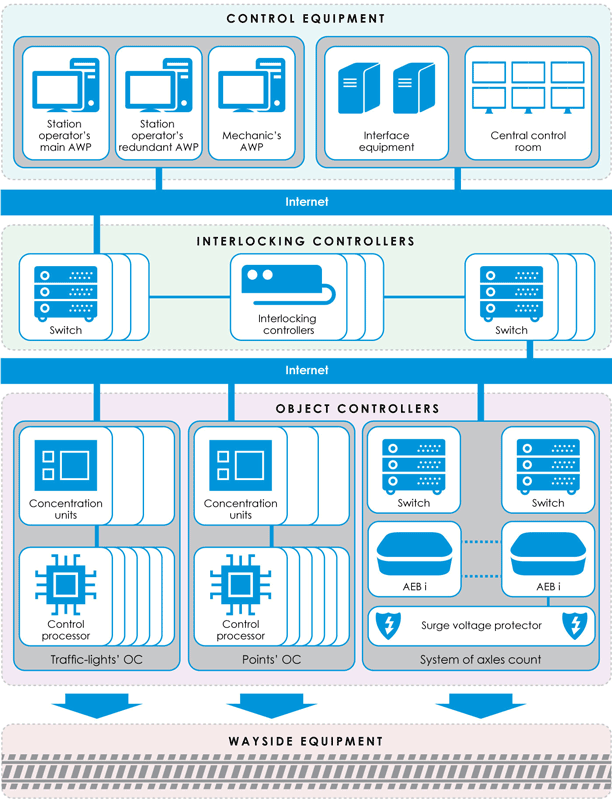Universal Micro-Processor Based Interlocking
The development of railway automation systems involves replacing existing relay systems with the microelectronic computer systems to control the movement of trains.
Currently, microprocessor-based technology is one of the most popular means of rolling stock movement control all around the world.
Universal microprocessor-based interlocking system (UMBIS) is a set of devices, providing route setting, route locking and route releasing at the station as well as testing of the execution of the required interdependencies.
The first priority goal of UMBIS development and integration is to reach a new level of safety and efficient operation of the rolling stock.

System Functions
The UMBIS system performs all relevant microprocessor technology based functions of traffic control that uses the software level to control signaling arrangement at the station limits and on running lines. The basic principle of the hardware setting down is to get the maximum possible routing control.
The UMBIS system is intended to:
- enable the transmission of diagnostic information to the higher-level systems;
- extend the functional capabilities and efficiency of the operational staff;
- reduce the cost and capacity of installation works;
- shorten the maintenance time for signaling arrangement as well as recover time in the case of equipment damages or failures.
Performance Capabilities
- Compliance with the European and international safety standards.
- High availability: use of standard industrial modules, hardware and software are tested at the factory, the fully tested and debugged equipment is delivered to the premises.
- The modular design concept: the ability to increase the number of managed objects.
- Distant control of signals and points with the help of intelligent object controllers.
- Advanced system diagnostics: detection of pre-failure conditions of the equipment.
- Redundancy protection of the principle system’s components.
- Possibility to set down the equipment in both centralized and decentralized way.
Level of Control Equipment (AWP)
The UMBIS system structure is modular, meaning hardware and software can be reconfigured according to the customer’s requirements.
Level of control equipment (AWP) includes main and redundant AWP of the station operator and the mechanic’s AWP. AWPs are intended to display the automation objects’ states in the readable mnemonic diagram of the station, provide command input, inform a station operator and a mechanic of usual and unusual events, display diagnostics data, archive events.
Level of Interlocking Controllers (IC)
Level of Interlocking controllers (IC) is built on the redundancy scheme «2 of 2» or «2 of 3». Each channel of the interlocking controllers is equipped with:
- galvanically isolated power-supply and control circuits;
- independent power sources.
Level of Object Controllers (OC)
Level of Object Controller (ОC) consists of object-oriented dedicated controllers that manage wayside equipment of points and traffic lights. All controllers have a safe structure «2 of 2» or «2 of 3» and in case of data fit in the microprocessor, the commands are given to the wayside devices via digital connection. Each OC has its own unique address that is assigned to hit by encoding mounting seats.
Construction
UMBIS is a system where the equipment is usually set down centrally and arranged into constructions to provide easy and comfortable installation and operation, access to all replaceable units and control units.
The construction of the UMBIS system elements are designed to consider the worst operating conditions and the processes that damage structural materials (corrosion, erosion, aging, wearing, etc.).
Integration
UMBIS can be integrated with relay station and running line systems, with microprocessor automation systems, with field equipment that is authorized for operation.
UMBIS has a user friendly interface and does not require additional devices to connect with related control systems: power supply system, trains speed control system, etc.
Advantages of Implementation
Adaptability. The offered solution allows to adapt the system for use on the main and industrial railway transport lines and underground depots.
Safety. Safety of micro-processor based interlocking system is achieved by means of hardware redundancy (UMBIS controllers, interface loops) and the use of the control policy «2 of 2» or «2 of 3», which means the executive of objects are activated only if appropriate commands are duplicated at the both outputs of the system’s channels.
To avoid dangerous situations caused by the accumulation of failures in the control computer complex constant monitoring is carried out to check the information identity in the channels of the computer system.
Reliability. Reliability of the UMBIS is provided by hot redundancy of all nodes of the system and structural redundancy of communication channels.
Continuous monitoring and diagnostics of microelectronic devices’ state ensure timely detection and troubleshooting of pre-failure conditions.
The system features an effective surge protection, minimizing the impact of external interference on the microprocessor device.

